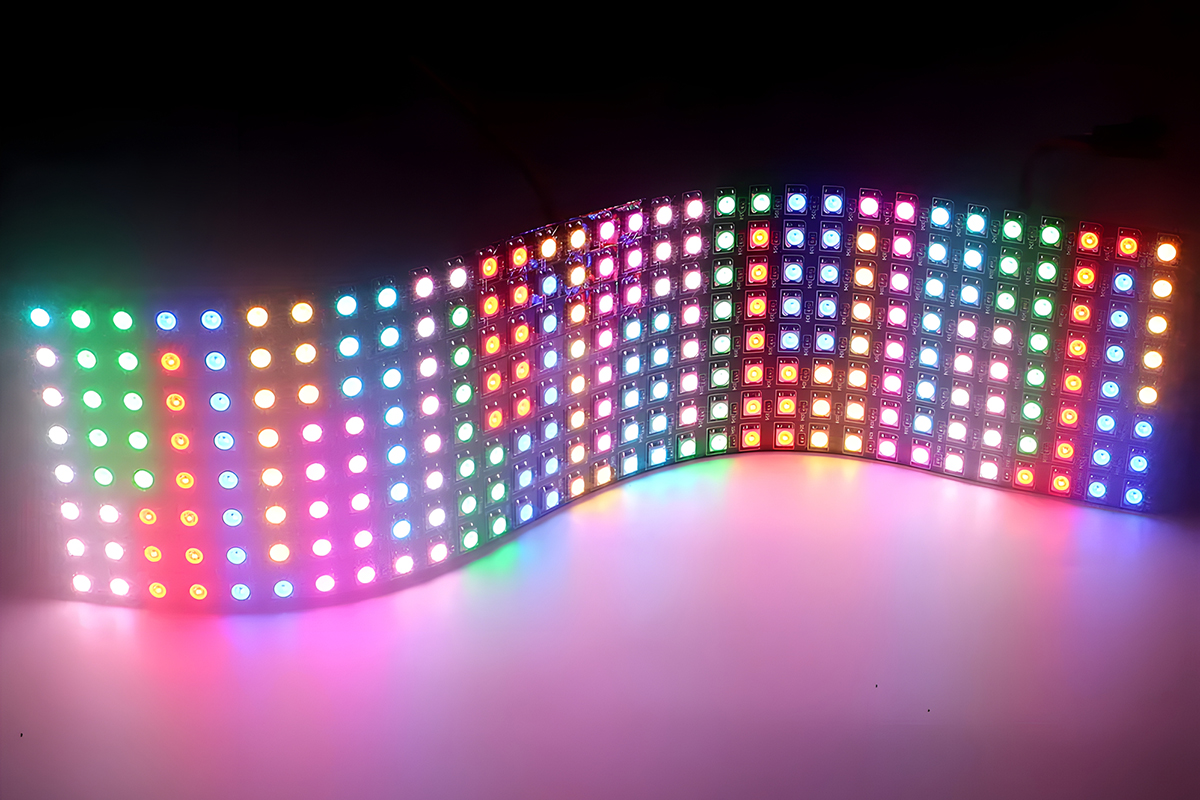Table of Contents Hide

What is an LED matrix panel
An LED matrix panel is an electronic display that is composed of an array of individually addressable LEDs arranged in a grid or matrix format. Also known as LED pixel panels or LED dot matrix displays, these LED panels are characterized by their ability to form patterns, graphics, and animations by independently controlling the brightness and/or color of each LED within the matrix. They are commonly used to create dynamic visual displays, such as pixelated graphics, animated patterns, synchronized lighting effects, information boards, and decorative installations.LED matrix structure
An LED matrix panel is typically constructed on a printed circuit board (PCB). The PCB serves as the substrate on which the individually addressable LEDs are soldered and interconnected. The choice of PCB material depends on factors such as cost, thermal performance, and mechanical requirements. LEDs are mounted on the PCB in a matrix configuration, with rows and columns. Each LED in the matrix is called a pixel. The pixel density determines the resolution of the display: the smaller the pixel density, the more detailed the image displayed. The PCB is embedded with circuitry for power distribution, data transmission, and control signals. LEDs in each row or column often share a common cathode or anode, respectively, which simplifies the wiring and control of the LEDs. Multiplexing is a technique commonly used in LED matrix panels to reduce the number of required pins on the microcontroller.Individually addressable LED lighting
In the matrix display, each LED is connected to a unique address, enabling the controller to identify and control its color and brightness. The LED is typically an integrated package or assembly of one or multiple LEDs and an LED driver. It can be monochrome (single color, usually white, red, green, or blue) or RGB (Red, Green, Blue) for full-color displays. The control circuitry within the LED driver decodes the incoming data signal. In RGB, RGBW, RGBA and other multi-channel LED packages, adjusting the intensity of the LED channels individually allows for the creation of a vast spectrum of colors. The color mixing ratio determines the final hue, saturation, and brightness of the emitted light. By continuously adjusting the color mixing ratios over time, smooth color transitions and dynamic color animations can be achieved. Uniquely addressing and controlling the color-changing LEDs on multiple pixel nodes simultaneously enables dynamic sequences, graphics, and complex translation of video content on LED matrix panels. For RGB LED matrix panels, each color channel is often controlled independently using pulse width modulation (PWM). PWM based LED drivers can provide accurate dimming control of the component LEDs for accurate color mixing.Communication protocol
The LED driver works with specific communication protocols such as Serial Peripheral Interface (SPI), I2C (Inter-Integrated Circuit), Parallel Interface, UART (Universal Asynchronous Receiver-Transmitter), DMX (Digital Multiplex), Ethernet (TCP/IP), wireless protocols (Bluetooth, Wi-Fi), and custom protocols designed for proprietary systems or specific applications. These communication protocols define how the digital data is structured and transmitted. The choice of communication protocol depends on the specific requirements of the LED matrix panel application, such as the size of the display, pixel density, data transfer rate, color accuracy, power consumption constraints, and the need for remote control or network integration. The refresh rate of addressable LEDs affects the smoothness of color transitions and animations. The speed at which the data signal is transmitted determines the refresh rate.LED matrix panel controller
A controller or microcontroller is used to manage the operation of the LED matrix. It communicates with the LED matrix using a specific communication protocol, sending data signals and instructions to each LED. Programmable microcontrollers or controllers allow for the creation of custom sequences and animations. For displays that involve user interactivity, the LED controller may handle input from sensors, buttons, or other input devices. In certain applications, LED matrix panels may be integrated into larger systems, and the system controller facilitates communication and synchronization with external devices or controllers. The type of controller or microcontroller used can vary depending on the complexity of the display.To operate LED matrix panels with complex animations, high-performance processors are essential. These devices can be FPGAs (field programmable gate arrays), graphics processing units (GPUs), microcontrollers with integrated graphics processing units (MCUs with GPUs), digital signal processors (DSPs), or application-specific integrated circuits (ASICs). Microcontrollers based on ARM Cortex-M cores (such as STM32 or Teensy boards), ESP32, Arduino Due, Raspberry Pi, NVIDIA Jetson Nano, Xilinx or Altera FPGAs, and NVIDIA Jetson AGX Xavier are some of the commonly used LED matrix panel controllers.
Last edited by a moderator:













